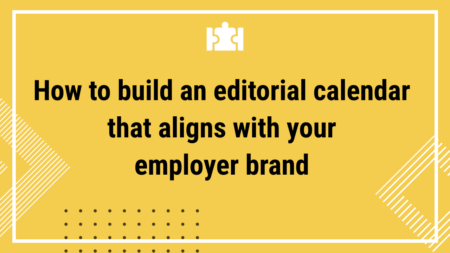Employer branding initiatives had a strong kickoff at the beginning of 2022. Organizations at large seemed eager to know more about its potential and explore its benefits. Amid lost reputations, shattered cultures, unengaged employees, and the need to keep a competitive advantage, employer branding rose to become more than a fancy role title.
However, as 2022 unfolded, adoption was still very slow. Economic uncertainty was accentuated, and as a consequence, the events of last year created more ripple effects. The Great Resignation morphed into The Great Sabbatical, forcing employees to reassess their work and life priorities. Unengaged employees who couldn’t afford to resign triggered a phenomenon called quiet quitting.
At first, organizations didn’t have an issue with it. But in Q3 of 2022, many realized that employees were starting to lack purpose and motivation. As quiet quitters continued to fulfill basic responsibilities, some executives noticed a significant decrease in productivity. In an attempt to restore happiness at work, leadership-buy moved from trend to fact.
As DE&I initiatives flourished and more focus was put on reframing EVPs, talent acquisition managers joined forces with HR leaders to provide better employee experiences. And yet, 2022 ends with massive layoffs; a kick in the gut for organizations claiming to have implemented all of the above initiatives.
What’s next for employer branding in 2023? Read more to find out:
Building authentic EVPs & authenticity in general
Every year, organizations spend roughly $2,500/employee on employee experience, an investment estimated to accentuate even more in 2023. The focus has always been on retention, however, considering recent events happening in the job market, establishing trust is easier said than done.
Recent EVP research done by Gartner on 85 HR leaders and 5,000 employees points out that the main challenge is that the focus is centered around “what to give an employee” rather than “why”. In 2023, it is predicted that a company’s EVP will become an ecosystem of values, support, and recognition; not just a set of benefits.
Every organization cares about retention, and it’s no secret that losing employees means losing productivity, at the same time decreasing brand reputation. The road to retaining top talent has been paved with challenges in 2022. “Exciting” organizations have lost their flair, proving once more that at the end of the day it all comes down to their ability to provide a stable, healthy work environment.
Organizations with a transparent EVP can decrease annual employee turnover by almost 70%, boosting commitment among new hires by 30%. Furthermore, 57% of recruiters today pinpoint that their biggest challenge is understanding how their company differs from the competition. Amid such turmoil in the candidate market, it pays to know how a transparent EVP can be used to attract and retain top talent.
“The reality is that three shifts in the work environment have eroded the impact of the traditional EVP: Employees are people, not just workers; work is a subset of life, not separate from it; and value comes through feelings, not just features,” Carolina Valencia, VP, Gartner.
Action to take for 2023
Approach your EVP from a more human perspective, and ditch the old paradigm that an EVP is just a set of employee benefits used as a magnet to attract new hires. See it as an ecosystem of values, support, and recognition. Aim to empower employees with authentic values and don’t shy away from the challenges associated with working in your company.
Redefining the notion of job stability in 2023
Throughout 2022, we’ve seen several changes happening in the job market. Although job vacancies increased, candidate applications dropped significantly, strengthening the fact that 2022 was a candidate’s market. Recruiters had to put more energy and time into ensuring that candidates have a memorable interviewing experience.
But that’s not all as the notion of job stability has changed the way companies view the employer brand function. From an employee’s perspective, 2023 will be about real balance at work and in life; a kind of balance that focuses less on increasing salaries and more on providing job stability.
The massive layoffs phenomenon of 2022 was triggered by economic uncertainty. Research by Goldman Sachs highlights that “higher interest rates and tighter financial conditions disproportionately impact the sector because tech company profits are typically expected further out in the future and therefore subject to greater duration risk.”
Laying people off has consequences, and when it is done abruptly and without any warning, it leads to repercussions that can’t be fixed in a month. It might take years before Twitter, Netflix, Coinbase and other notable tech giants get their brand reputation back.
It is predicted that the economic crisis will continue next year. As a consequence, successfully recruiting new candidates in the tech industry will depend on the transparency level of a company’s employer brand. For HR professionals and recruiters to be able to provide a safe space for new hires, employer branding initiatives need to be reframed. An action plan capable of demonstrating how EVPs are put into practice will help hiring managers recruit better, at the same time guaranteeing new employees they won’t be laid off.
“I think what we will start to see is organizations become a lot more strategic and longer-term with how they protect their reputation as an employer. And I think what that means is more organizations are going to realize that they need to invest in the alumni community. A big component of protecting your reputation over the long term is how you treat people when you’re offboarding, and how you engage with them and retain some element of the community after they’ve left.”
(Bryan Adams, CEO & Founder of Ph.Creative – Employer Branding T.I.P S06Ep.6)
Action to take in 2023
The events of 2022 should be a lesson to every executive, recruiter, talent acquisition specialist, and hiring manager out there thinking about hiring new employees. Before taking any steps further, truly assess whether or not your company can provide the stability people will crave in 2023.
It won’t be about comfortable, cozy jobs that lack substance and motivation; quite the opposite. Redefining job stability in 2023 will be about making promises that you can keep. Start by seeing candidates and employees as humans rather than ROI machines. Consider their well-being in “sickness and in health”, and find ways to put company values into action.
Last but not least, it’s okay to lay people off. Priorities change, people change, and company goals change. However, it’s critical to be gentle and treat people with the respect that they deserve during the offboarding process. Otherwise, they’ll lash out online and offline, causing irreparable damage to your employer brand.
It is possible to lay people off and not lose your reputation if you every single resource, every single ounce of effort and creativity that you want to drive your employer brand and protect that reputation. And you give it to the people that you’re about to impact. It’s going to take a hit and you’re going to get some some ratings and reviews that don’t align with who you want to be. But overwhelmingly, what’s going to happen is people are going to understand the investment that you made in helping them make that transition; whether that’s outplacement support, how you communicate with them, even as little as the message that you send to them to let them know why this thing is happening – the tone, the voice, the words, and how you want to support them and refer to them after they’re gone. That’s going to help you move forward because people understand that how you react in the worst situation reveals your character.
Bryan Chaney –
Onboarding – a recruiting focus No. 1
There’s a talent pool of 25,000 former Silicon Valley employees who will search for new job opportunities in 2023. While having worked for Amazon or Twitter stands out on a resume, let’s not forget about the equally qualified former employees of smaller tech companies. All things considered, It is safe to assume that recruitment in 2023 will look slightly different, inevitably changing the onboarding process.
Onboarding in 2023 is no longer about orientation, but about culture and shared values. Every new employee’s first month in an organization should make them feel safe and accepted. Rather than view onboarding as a trial period of accommodation, make sure it paints a complete picture of your company’s employer brand; including the pros & cons, the challenges, and the not-so-pretty aspects of the job. Candidates today are smarter than ever; sooner rather than later, they’ll pick up on the lies.
Conventional onboarding is not role-specific, but rather general and impersonal. As a result, it lacks customization and a sense of individualization. To address this concern, tailoring onboarding to match every role enables new hires to feel that their needs are being met, thus boosting engagement, motivation, and enthusiasm.
Employee accountability will go a very long way throughout the onboarding process in 2023. The honest employer brand of 2023 will have a “give & get” approach where employees and the company exchange mutual value. This way, you’ll empower your new hires to take charge and own up to their decisions from the beginning.
Action to take in 2023
In 2023, the process of onboarding will be either exciting or terrifying. The latter scenario usually happens when you have a weak employer brand; when what candidates see is not what they get; when you lie to cover challenges and mask the truth. Why should hiring managers walk on eggshells and fear that a new hire will quit in 3 months?
Recruiting qualified candidates (and retaining them) following the massive layoff phenomenon of 2022 can only be done successfully if you’re authentic from the very beginning – a culture centered around a genuine EVP and shared values works hand in hand with speaking the truth in terms of challenges. This way, you won’t have to walk on eggshells and pretend that you’re perfect; because you’re not and neither is your new hire.
Omnichannel employer branding in action
If you’re not already doing omnichannel employer branding, chances are you will. Building your reputation online will matter just as much as building it offline. Testing out different channels, going abroad to hire remotely, and taking into consideration strategies that seemed far-fetched in 2022 will be the new normal next year.
In the absence of trust, hiring tech talent will push leaders to approach employer branding differently. Employees are quitting faster, some of them the moment they realize they lack the motivation to stay. Having an omnichannel approach to attracting and retaining top talent gives companies leverage. Whether it’s organizing social events and meeting face-to-face or launching a global employer branding campaign, next year we’ll see a lot of fresh new initiatives take place.
In 2023, recruiting tech talent will have to go beyond LinkedIn ads and messages. Candidates no longer want to get fooled by pretty words and amazing benefits. They want to see your employer brand in action. Team leads holding webinars, hackathons, social events, and leaders speaking at conferences are just some of the initiatives we’ll see happen in 2023. For a company’s employer brand to pique candidate interest, leaders will have to get more involved. Why should candidates join you? How will you address their fears? What strategies do you have in place to ensure job stability and combat challenges?
Action to take in 2023
Get ready to answer some questions next year! The key to securing your reputation as an employer will be honesty. And the best way to clear the air is face-to-face. There’s only so much the online realm can do for your reputation. Having an active social media presence matters as it gives some idea of what it’s like to work in a certain company. But nothing compares with in-person interaction as it enhances emotions, enabling candidates to sense whether or not their values match yours.
The “people-first” approach in employer branding will accentuate
The HR space has gotten used to how important it is to have a strong employer brand. However, there seems to be a shift in what works and doesn’t work anymore. The strategies used in 2022 are fading away as candidates are no longer fooled by EVPs that only look nice on paper. A new trend in employer branding in the “people-first” approach. Some companies are already putting people at the heart of every decision they make.
At the end of the day, people work for people, not for organizations. A strong, authentic employer brand is like a beacon because it has the power to draw people in. In 2023, smart organizations will take this approach even further, building targeted EVPs capable of attracting specific talent pools. It could be a dedicated Career Page for women in STEM candidates, for example; pages that showcase specific content that appeals to a certain segment of candidates, enabling organizations to focus better on the needs and wants of that group.
It’s no secret that candidates crave employee testimonials and unedited stories. Imperfect content makes an organization “feel alive”, and 2023 is the perfect year to prove that imperfections make you real as an employer. How can imperfection and authenticity be trump cards for companies looking to build their employer brand?
— “How could it not be that? It’s the start of an extremely important relationship and collaboration. The impact that going wrong can have on you, as a person, and the impact that can have on the employer and the company is absolutely huge. It’s not about selling them a dream. The worst result of a recruitment campaign is not failing to hire someone; it’s hiring the wrong person. And the wrong person isn’t a bad person. It could be someone for whom you’re not a great choice in terms of what matters to them. And the worst result of hiring the wrong person is not if they quit quickly, it’s if they stay.”
( Mark Puncher, CEO at @Employer Branding Australia – Employer Branding T.I.P S06Ep.5)
Action to take in 2023
With 53% of employees feeling more exhausted now than before the pandemic and 57% of them experiencing increased anxiety due to work-related factors, it’s no wonder caring about employees as people first will play a huge role in shaping employer branding strategies next year. Authentic stories don’t just strengthen brand reputation, they draw in candidates that resonate with what your current employees have to share.
Listen more, talk less in 2023! Whether you’re an HR manager, a founder, a team lead, a recruiter, 2023 will be about the people in the employer brand. The more you know about how they feel, what they need, and why they like/dislike working with you, the better chances you have to take that information and frame it into a culture of transparency and trust.
Closing thoughts
Trends and predictions aside, 2023 will be about using every resource that you have to protect your employer brand. Whether or not you have plans to recruit or you just want to take care of current employees, every decision that you make should be made with employer branding in mind. Internal actions will, at the very least, help with retention.
Needless to say, nothing guarantees employee retention in a bear market. But it doesn’t hurt to use the resources that you have to bring people closer and make them feel that they belong with your organization. If used wrong, your budget for 2023 – no matter how large – will make candidates and employees pull away. Steer clear of content without substance, promises you can’t keep, and values that are identical to those of some other tens of companies out there. Focus on the challenges, and find ways to flip them into an actionable employer branding strategy that emphasizes your uniqueness.






